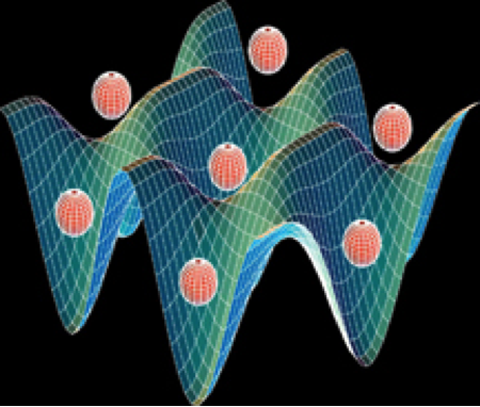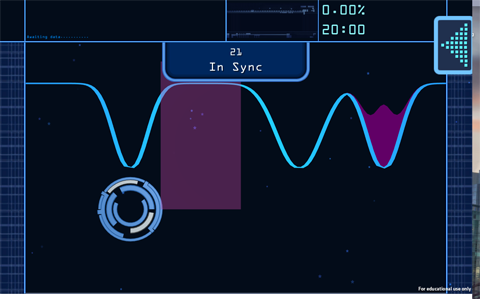Quantum Computing, Human Processing
May 20, 2016
Quantum computing has been envisioned for decades, but is a difficult task to accomplish. Now, one research group is crowdsourcing human ingenuity to solve the problem—by turning it into a game.
Computers
Any computer system requires operations that result in a change in a physical system that leaves that system in a certain physical state. Two important requirements of a physical computing system are the ability to reproduce a physical state, and how long the created state lasts. These two quantities are known as fidelity and lifetime, respectively.
For a quantum computer, the degree of fidelity (how well the physical state can be reproduced) usually must be greater than 99.9%, depending on the physical system. The requirement is based on the ability to correct any errors that occur in the physical system so a build up of error does not occur. The requirement that executing an operation must occur faster than the lifetime of the quantum state, or what is typically called the quantum decoherence time, is difficult—if you try to execute an operation too quickly, you lose fidelity. Optimizing these two conditions has led scientists to rely on computer programs—algorithms—to try out many initial states and conditions. The algorithms are good, but there are an extremely large number of possibilities to try.
In a typical hard drive, it’s the orientation of small magnetic particles that represents the series of 0s and 1s of computer code—calculations and other operations involve reading and changing these orientations. So what might create the physical states in a quantum computer? One construction would be to have cold, neutral atoms trapped in an optical lattice. An optical lattice is created by first having a laser beam, say headed to the right, added to its reflected beam headed to the left. The addition of the two counter-propagating beams forms a standing wave, much like a standing wave formed on a stringed instrument. [See Physics Girl5 for more about standing waves.] Next, have another laser beam headed in the vertical direction, added with its reflected beam, cut through the first beam set. This causes an interference pattern resulting in a series of standing wave patterns. Adding a third set of laser beams perpendicular to the first two sets causes a further interference pattern, slicing layers with well defined hills and valleys, similar to egg trays set above and below each other with equal spacing. Once the lattice is formed, one can look at one layer (one egg tray) and trap neutral atoms within it.

Artistic rendition of atoms in an optical lattice.
Image Credit: Public Domain
The atoms then have the potential to tunnel through to the next "well," flowing like a fluid from one well to another or, depending on the depth of the well and how strongly the atoms interact with each other, they can get trapped in the well and stay put.
Being able to control the physical state is part of what makes it possible as a quantum computer. By changing the power of the laser, one can make the wells deeper in the optical lattice, and by changing the wavelength or angle of the lasers, one can adjust the periodicity of the lattice. Having atoms trapped in an optical lattice in a neatly arranged array is what makes this a great choice as a physical system for quantum computing.
To implement computations, one might use long range gates, (for example two atoms might interact with each other via the electric charge of their valence electrons) that results often in a rotation of a quantum state and can be used for logic commands such as “not,” which contains one piece of information. The “not” command flips a single bit of information—in binary, if something is NOT a zero, it's a one. In the realm of quantum computing a bit is called a qubit to indicate it is connected to a quantum computer. However, what gives quantum computing a tremendous advantage over current computing systems is that one can create an entangled state – a state that contains information about two physical states. An example of using long range gates that use 2 qubits and hence can create an entangled state, is the “cnot” command, which flips a value if and only if a control qubit is in a particular state.
Another way to implement computations is to have contact interactions. One might move an atom onto another atom. This is done using an optical tweezer, which is a narrowly focused laser beam that does not have a resonant frequency with the system. The optical tweezer can “grab” onto the atom and move it from one position to another – for example, a position where another atom is located in the optical lattice. When this happens the two atoms alter each other’s states. This can result in a SWAP gate, which basically results in the two atoms exchanging two bits of information (two quantum state variables). It can also result in a "√SWAP" gate (squareroot SWAP gate), which is an entangled state. The entangled state is created by only allowing half the time needed to completely swap the quantum state variables, thus the system is left in a state containing information about both possible quantum states.
The Crowd to the Rescue
Researchers at Aarhus University in Denmark are working on how to move an atom trapped in a well in the optical lattice to another location as quickly as possible, and with high fidelity, using an optical tweezer. Rather than having their algorithm go through the many, many possibilities, they had the idea to narrow down the choices by turning the problem into a game, and use the crowdsourced data from it as a starting point for their algorithm.
Coming up with a game that simulates the situation of a quantum state being moved along by optical tweezers could not have been easy. The quantum state of the atom is given by its wavefunction. The researchers depicted the wavefunction as a fluid (water) inside a “well.” The player grabs on to the well using the tweezers and manipulates its position and depth to move the fluid to the new location. This is only one of a series of ScienceAtHome Quantum Moves games, and it is called “BringHomeWater.” BringHomeWater is FUN! (Download it and give it a try!) Be careful not to move too quickly because the water begins to slosh around and get out of the well, mimicking excitations of the wavefunction if too much energy is imparted to it.

A screenshot from gameplay of Quantum Moves, where players manipulate potential wells to move the wavefunction (purple fluid) into the target region.
Image Credit: Sørensen, et al.
Surprising Results
BringHomeWater Quantum Moves has players go through a series of levels that are training exercises. After successfully completing these levels, players go on to play at the scientific level. According to the research article there were about 12,000 plays at the scientific level by about 300 players.1 The results have a large range in fidelity and time, but the players trace out a region of solutions around the best numerical results using their optimization algorithm. The numerical results were obtained by the algorithm trying over 100,000x more trials than the players!1 Furthermore, the researchers note that the players find better solutions for short time durations than the numerical algorithms, however with lower fidelities.
This has led the researchers to consider the hybrid approach of using player results as starting points for numerical optimization algorithms.
Before the publication of the researchers’ Nature paper,1 there were a total of 10,000 players who played 500,000 times on the various levels of Quantum Moves. Since the publication of the paper there have been more than 120,000 players that have played more than 6,000,000 times! The researchers are delighted. Jacob Sherson stated, “These players have already generated even better data results than what was published in the Nature paper.”
Future Research & Applications
Quantum Moves BringHomeWater focuses on using the optical tweezer to move the atom. The actual merger of two atoms is one of the next levels in the ScienceAtHome Quantum Moves game.
The games’ strategies are believed to be applicable to other physical interactions such as many-body dynamics in optical lattices and Bose-Einstein condensates.1
The researchers are planning on “launching an interdisciplinary effort with physicists, psychologists, cognitive researchers, and computer scientists to find out more about the human mechanism of intuitive problem solving that enables the players to come up with such novel solutions.”
The researchers note in their paper that their “future work will focus on extending gamification strategy and also the more general classification methodology to new types of control problems...,” and “how the players form strategies.”1
At the ScienceAtHome Quantum Moves website, there is already a game called “QuantumMinds” that focuses on studying the process of human strategy formation, as does the “Skill Lab,” which works on mobile devices. The information gathered will help the researchers better understand “which cognitive skills are required to successfully contribute to the solution of an actual quantum research challenge.”
References and Resources
1. Sørensen, J.J.W.H., et al., Exploring the quantum speed limit with computer games, Nature 532, 210-213 (14 April 2016) | doi:10.1038/nature17620
http://www.nature.com/nature/journal/v532/n7598/full/nature17620.html
2. Wikipedia. https://en.wikipedia.org/wiki/Optical_lattice
3. Anderlini, M, et al., Controlled exchange interactions between pairs of neutral atoms in an optical lattice, Nature 448, 452-456 (26 July 2007) | doi:10.1038/nature06011;
http://www.nature.com/nature/journal/v448/n7152/abs/nature06011.html
4. Quantum Moves Games: Bring Home Water.
https://www.scienceathome.org/games/quantum-moves/game
5. Physics Girl for a description of creating standing waves.
https://www.google.com/?client=safari#q=physics+girl+standing+waves
—H.M. Doss














